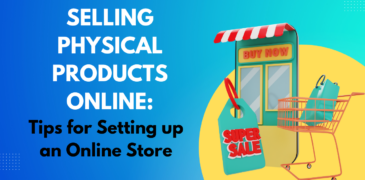Step into the dynamic realm of e-commerce! With the advancements of the digital era, the opportunity to sell tangible goods online has never been more within reach. Whether you’re a budding entrepreneur or an experienced business owner seeking to broaden your horizons, establishing an online store can revolutionize your trajectory. In this all-encompassing manual, we’ll provide you with invaluable advice and perspectives to effectively navigate the journey of initiating and managing a prosperous online store.
Gone are the days when brick-and-mortar retail was the only option. With the advent of technology and the increasing popularity of online shopping, consumers now have the convenience of browsing and purchasing products from the comfort of their homes. As a seller, this presents an incredible opportunity to tap into a global customer base, transcend geographical boundaries, and grow your business exponentially.
Why Sell Physical Products Online?
Selling physical products online offers a myriad of advantages for entrepreneurs and businesses alike. Here are a few reasons why setting up an online store can be a game-changer:
- Global Reach: By establishing an online store, you can reach customers from all around the world. The internet eliminates geographical limitations, enabling you to expand your customer base far beyond your local market.
- 24/7 Availability: Unlike a traditional physical store with set operating hours, an online store is open for business 24/7. This means potential customers can browse and make purchases at their convenience, even while you sleep.
- Cost-Effectiveness: Running an online store typically requires lower overhead costs compared to maintaining a physical storefront. There’s no need to worry about rent, utilities, or other expenses associated with a brick-and-mortar location.
- Flexibility and Scalability: An online store offers unparalleled flexibility. You have the freedom to manage your business from anywhere, allowing for a better work-life balance. Additionally, as your business grows, you can easily scale up your operations to meet increasing demand.
Tips for Setting up an Online Store
Now that we understand the advantages of selling physical products online, let’s dive into some valuable tips to help you establish a successful online store:
Establish Your Niche and Target Audience:
- Prior to establishing your online store, it is vital to define your niche and target audience. Clearly identify the specific products you intend to offer and conduct thorough market research to gain insights into the needs, preferences, and purchasing habits of your target customers. This understanding will serve as a compass, shaping your product selection, branding, and marketing approaches.
Choose the Right E-Commerce Platform:
- Selecting the right e-commerce platform is vital for the smooth functioning of your online store. Look for platforms that align with your business requirements, offer user-friendly interfaces, robust features, secure payment gateways, and customization options. Popular e-commerce platforms include Shopify, WooCommerce, BigCommerce, and Magento.
Develop an Appealing and Intuitive Website:
- The website for your online store serves as a virtual storefront, so it’s essential to craft an engaging and user-friendly experience. Design a visually appealing website that aligns with your brand identity and elevates the overall shopping journey. Prioritize mobile responsiveness, swift loading times, intuitive navigation, and captivating product imagery paired with compelling descriptions.
Optimize for Search Engines:
- Implementing search engine optimization (SEO) strategies is crucial to improve your online store’s visibility in search engine results. Conduct keyword research related to your products and optimize your website’s content, meta tags, headings, and URLs accordingly. Additionally, focus on building quality backlinks and providing valuable, informative content to attract organic traffic.
Formulate an Effective Marketing Strategy:
- Creating awareness and driving sales for your online store necessitates a robust marketing approach. Harness diverse marketing channels including social media, email marketing, influencer partnerships, content marketing, and paid advertising to connect with your target audience. Craft persuasive product descriptions, captivating social media campaigns, and impactful email marketing initiatives to enhance brand visibility and entice customers to make confident purchases.
Streamline Your Order Fulfillment and Shipping Process:
- Efficient order fulfillment and shipping are crucial to providing a positive customer experience. Choose reliable shipping partners and establish streamlined processes for inventory management, order processing, packaging, and shipment tracking. Offering fast and reliable shipping options, along with clear communication regarding delivery times, can significantly impact customer satisfaction and encourage repeat business.
Provide Excellent Customer Support:
- Exceptional customer support is a cornerstone of successful online stores. Be responsive to customer inquiries and provide multiple channels for communication, such as email, live chat, or phone. Address customer concerns promptly and go the extra mile to ensure customer satisfaction. Positive reviews and word-of-mouth recommendations can greatly boost your store’s reputation and credibility.
Monitor Analytics and Make Data-Driven Decisions:
- Utilize analytics tools to track key performance metrics, such as website traffic, conversion rates, average order value, and customer behavior. Analyzing this data will help you identify areas for improvement, optimize your marketing strategies, and make informed business decisions to drive growth and profitability.
Also read:
Ways to Move to a New Level with your Online Store
How to Use Social Media to Grow Your Online Store
How To Make Your Online Retail Store Highly Successful
Apple Offline and Online Retail Stores in India
FAQs
Do I need technical expertise to set up an online store?
Not necessarily. Many e-commerce platforms provide user-friendly interfaces and step-by-step guides to help you set up your online store without technical knowledge. However, if you want more customization options or require advanced features, you may consider hiring a web developer or designer to assist you.
How do I handle payment processing on my online store?
E-commerce platforms often integrate with various payment gateways, allowing you to securely process customer payments. Popular payment gateways include PayPal, Stripe, Square, and Authorize.net. Choose a payment gateway that is compatible with your chosen e-commerce platform and offers reliable and secure transaction processing.
What should I consider when choosing product packaging for shipping?
When selecting product packaging, consider the size and fragility of your products. Opt for packaging materials that provide adequate protection during transit, such as boxes, bubble wrap, air-filled cushions, or padded mailers. Additionally, consider branding opportunities by including your logo or custom packaging materials that reflect your brand identity.
What are effective ways to promote my online store and attract customers?
Promoting your online store is essential to draw in traffic and foster sales. Implement a range of digital marketing strategies, including social media marketing, search engine optimization (SEO), content marketing, influencer partnerships, email marketing, and paid advertising. Develop captivating content, leverage the power of social media platforms, and establish meaningful connections with your target audience to enhance brand visibility and captivate potential customers.
What is the importance of mobile responsiveness for my online store?
Mobile responsiveness is vital for your online store because an increasing number of consumers shop using their smartphones and tablets. A mobile-responsive website ensures that your store adapts to different screen sizes and provides a seamless browsing and shopping experience for mobile users. Failure to optimize for mobile may result in a high bounce rate and lost sales.
How do I handle customer returns and exchanges?
Establish clear return and exchange policies that align with industry standards and customer expectations. Clearly communicate these policies on your website, including information on who covers the return shipping costs. Implement an efficient process for handling returns and exchanges, ensuring timely communication with customers and issuing refunds or replacements promptly.
Conclusion
Establishing an online store offers a thrilling prospect to expand your reach, boost sales, and establish a flourishing business on a global scale. By adhering to the recommendations presented in this guide, including identifying your niche, choosing the appropriate e-commerce platform, crafting an enticing website, employing effective marketing tactics, and placing customer satisfaction as a priority, you’ll be fully prepared to embark on your e-commerce venture. It’s important to remember that building a prosperous online store requires time, dedication, and ongoing adjustments. However, with unwavering commitment and a customer-centric approach, you can transform your online store into a thriving business endeavor.







